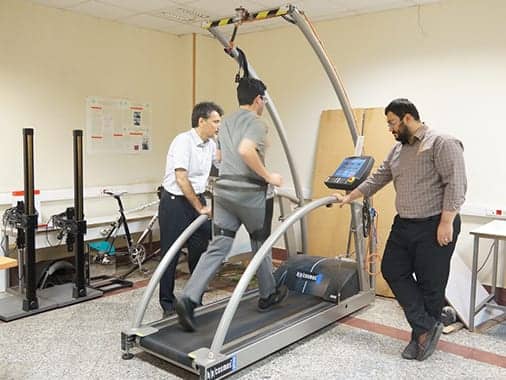
A team of scientists from the University of Tehran have developed an unpowered exoskeleton that they suggest could help reduce a runner’s metabolic rate. (Photo courtesy of Rezvan Nasiri)
A team of Iranian biomedical engineers has developed an unpowered exoskeleton that they suggest is able to reduce a wearer’s metabolic rate while running.
The research team is led by Rezvan Nasiri, and includes Arjang Ahmadi, and Majid Nili Ahmadabadi, all from the Cognitive Systems Laboratory, Control and Intelligent Processing Center of Excellence at the School of Electrical and Computer Engineering at the University of Tehran, in Iran.
A study describing the exoskeleton’s development and testing is featured in IEEE Transactions on Neural Systems and Rehabilitation Engineering.
“The exoskeleton we developed reduces the metabolic rate by 8% during running by using a rotational spring system which couples two hips in the sagittal plane. The device takes advantage of the ‘scissor kick’ motion that occurs naturally during running – the reciprocal motion of the body recycles that energy, thereby allowing us to create an unpowered exoskeleton. No external battery is required, making the device lightweight and unobtrusive,” says lead researcher, Rezvan Nasiri, in a media release from IEEE EMBS.
“Users do not need to run at a constant speed to achieve metabolic rate reduction. We look forward to testing our device under a wide variety of settings in our future work.”
The exoskeleton the team developed was tested on 10 healthy active subjects for running at 2.5 meters per second. The team repeatedly achieved 8% metabolic rate reduction when compared to the subjects running at the same speed without wearing an exoskeleton. The exoskeleton is entirely human powered, and does not have any motors, electrical systems, or sensors. The research team project that by reducing the mass of their device, up to 10%, metabolic rate reduction is possible.
“This new research is special because it has been incredibly hard to reduce energy costs of a physically intact human by adding a device to their legs. Achieving this is a tremendous breakthrough in the field of human augmentation because humans are so incredibly good at minimizing metabolic energy cost during locomotion. Until now, no one has been able to add a device to humans that could reduce that metabolic energy expenditure for running,” states Dr Rodger Kram, associate professor emeritus of integrative physiology at the University of Colorado, Boulder.
“The beauty of this new device really lies in its simplicity – at less than 2 kilograms, it is lightweight, and requires no external power. It is portable, quiet, and not at all bulky. I’m impressed by this team’s achievement, which has big implications for the running industry. It will be exciting to follow the innovations that result from their work,” he adds.
“This team has developed a very simple, elegant solution that integrates almost seamlessly into the body’s natural movement,” comments Dr Greg Sawicki, an associate professor of mechanical engineering and biological sciences at Georgia Tech, and head of the Human Physiology of Wearable Robotics Lab, the release continues.
“The team in Iran has found a way to remap the structure of the musculoskeletal system with little more than a spring, essentially giving runners the equivalent of a new body part and an alternative pathway for exchanging energy. Their research has tremendous implications for our field, and I’m excited to see what develops as a result of this trailblazing work.”
[Source(s): IEEE EMBS, Business Wire]


